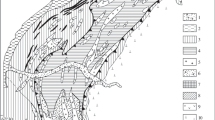Abstract
The Rabaul caldera is at the northeastern tip of the island of New Britain, Papua New Guinea. Unwelded pumice flows and air fall pumice of andesite, dacite and rhyolite drape the caldera. They contain sparse phenocrysts of plagioclase, pyroxene and rarely amphibole, together with microphenocrysts of titanomagnetite and ilmenite; apatite and pyrrhotite are also present. The equilibration temperature of the iron-titanium oxides range from 1035° to 835° C. Estimates of sulphur fugacity are obtained from the composition of the pyrrhotites which contain about 1% Cu and 0.3% Mn. Calculations show that the fugacity of SO2 may be several tens of bars at 1000° C. An estimate of the activity coefficient of Fe3O4 in titanomagnetite was obtained, and within the limits of error, can be taken as unity in the temperature range 835–1035° C and the composition range 22. 6–42.5% ulvospinel. Calculations suggest that the phenocrysts of orthopyroxene and titanomagnetite in the rhyolitic pumice equilibrated at pressures (P total) of between 2.2 and 2.6 kilobars. Estimates of pH2o are unreliable because of the presumed later hydration of the pumice.
Similar content being viewed by others
Reference
Anderson, Tempest, Flett, J. S.: Preliminary report on the recent eruption of the Soufriene in St. Vincent in 1902 and on a visit to Montagne Pelee, in Martinique. Part I. Roy. Soc. (London) Philos. Trans. A 200, 423–455 (1902).
Boyd, F. R.: The Yellowstone rhyolite plateau. Carnegie Inst. Wash. Yearb. No. 53, 139–140 (1954).
Boyd, F. R., Kennedy, G. C.: Some experiments and calculations relating to the origin of welded tuffs (abs.). Am. Geophys. Union. Trans. 32, 327–328 (1951).
Brown, G. M.: Pyroxenes from the early and middle stages of fractionation of the Skaergaard intrusion, East Greenland. Mineral. Mag. 31, 511–543 (1957).
Buddington, A. F., Lindsley, D. H.: Iron-titanium oxide minerals and synthetic equivalents. J. Petrol 5, 310–357 (1964).
Carmichael, I. S. E.: The iron-titanium oxides of salic volcanic rocks and their associated ferromagnesian silicates. Contr. Mineral. and Petrol. 14, 36–64 (1967).
Ewart, A., Carmichael, I. S. E., Brown, F. H., Green, D. C.: Voluminous low temperature rhyolite magmas in New Zealand. Contr. Mineral. and Petrol. 33, 128–144 (1971).
Fenner, C. N.: Incandescent tuff flows in southern Peru. Geol. Soc. Am. Bull. 59, 879–893 (1948).
Gilbert, C. M.: Welded tuff in eastern California. Geol. Soc. Am. Bull. 49, 1829–1862 (1938).
U.C.JANAF thermochemical tables. 2nd ed. Ed. by Stull, D. R., and Prophet, H.: National Standard Reference Data System, NBS-37; U.S. Dept. of Commerce, 1141 p. (1971).
Kozu, S,: The great activity of Komagatake (Japan) in 1929: Tschermaks Mineral. Petrog. Mitt. 45, 133–174 (1934).
Kudo, A. M., Weill, D.: An igneous plagioclase thermometer. Contr. Mineral. and Petrol. 25, 52–65 (1970).
Kuno, Hisashi: Characteristics of deposits formed by pumice flows and those by ejected pumice. Tokyo Univ. Earthquake Res. Inst. Bull. 19, pt. I, 144–149 (1941).
Lipman, P. W.: Iron-titanium oxide phenocrysts in compositionally zoned ash-flow sheets from Souther Nevada. J. Geol. 79, 438–456 (1971).
Lowder, G. G.: The volcanoes and caldera of Talasea, New Britain: mineralogy. Contr. Mineral. and Petrol. 26, 324–340 (1970).
Lowder, G. G., Carmichael, I. S. E.: The volcanoes and caldera of Talasea, New Britain: geology and petrology. Geol. Soc. Am. Bull. 81, 17–38 (1970).
Marshall, P.: Acid rocks of Taupo-Rotorua volcanic district. Royal Soc. New Zealand Trans. 64, 323–366 (1935).
Nicholls, J., Carmichael, I. S. E.: The equilibration temperature and pressure (Ptotal) of various lava types with spinel and garnet-periodotite. Amer. Mineralogist 57, 941–959 (1972).
Nicholls, J., Carmichael, I. S. E., Stormer, J. C., Jr.: Silica activity and Ptotal in igneous rocks. Contr. Mineral. and Petrol. 33, 1–20 (1971).
Nordlie, B. E.: The composition of the magmatic gas of Kilauea and its behavior in the near surface environments. Am. J. Sci. 271, 417–463 (1971).
Ross, C. S., Smith, R. L.: Ash flow tuffs: their origin; geologic relations and identification. U. S. Geol. Surv. Profess. Papers No. 366 (1961).
Smith, R. L.: Ash flow. Bull. Geol. Soc. Am. 71, 795–842 (1960).
Stormer, J. C., Jr., Carmichael, I. S. E.: The Kudo-Weill plagioclase geothermometer and porphyritic acid glasses. Contr. Mineral. and Petrol. 28, 306–309 (1970).
Stormer, J. C., Jr., Carmichael, I. S. E.: Fluorine-hydroxyl exchange in apatite and biotite: a potential igneous geothermometer. Contr. Mineral. and Petrol. 31, 121–131 (1971).
Toulmin, P. III, Barton, P. B.: A thermodynamic study of pyrite and pyrrhotite. Geochim. Cocmochim. Acta 28, 641–671 (1964).
Williams, R. J.: Reaction constants in the system FeO-MgO-Si2-O2 at 1 atm. between 900° and 1300° C: experimental results. Am. J. Sci. 270, 334–360 (1971).
Author information
Authors and Affiliations
Rights and permissions
About this article
Cite this article
Heming, R.F., Carmichael, I.S.E. High-temperature pumice flows from the Rabaul caldera Papua, New Guinea. Contr. Mineral. and Petrol. 38, 1–20 (1973). https://doi.org/10.1007/BF00371723
Received:
Issue Date:
DOI: https://doi.org/10.1007/BF00371723




